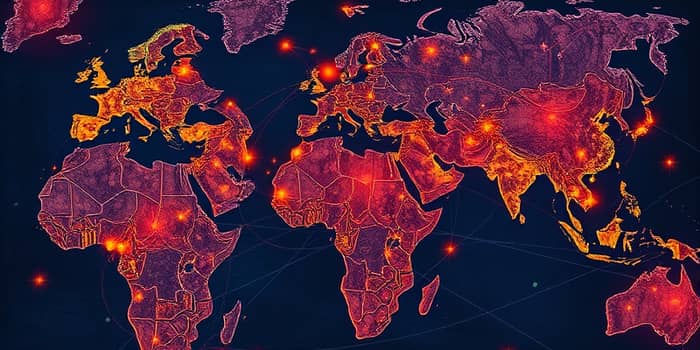
As global tensions intensify in late 2025, markets are buffeted by a complex web of conflicts and policy shifts. Investors, policymakers, and businesses find themselves at a crossroads where foresight and adaptability are paramount.
We live in an age defined by the most consequential global dynamic, where nations pursue divergent strategies in economics, security, and technology. Traditional alliances are shifting as countries embrace transactional engagement, and fragmentation has become the norm rather than the exception.
Chief risk officers around the world rank state-based armed conflict as the top risk for 2025, with over half forecasting an unsettled environment. This era of “multi-alignment” demands that market participants rethink long-held assumptions about stability and cooperation.
The US-China rivalry remains the epicenter of global strategic competition. Washington has proposed sweeping protectionist measures, including proposed tariffs of 60% on China and up to 20% on other key partners. These moves aim to safeguard critical technologies but risk igniting a spiral of retaliatory barriers.
Tech supply chains, especially semiconductors and AI components, are under unprecedented strain. Companies are compelled to “friend-shore” production, often at higher costs, and governments are stepping up investment in domestic capacity. Firms are forced to diversify suppliers at significant cost as they rebuild networks. The question looms: can the two superpowers manage their dispute without tipping into direct military confrontation, particularly over Taiwan and the South China Sea?
In 2025, the war in Ukraine drags on despite diplomatic overtures. Energy security has emerged as a defining concern for Europe. Dependence on Russian gas has been dramatically curtailed, driving up prices and stoking inflation across the continent.
EU policymakers face a stark choice: accelerate the energy transition or risk prolonged exposure to volatility. With growth forecasts between 0.8% and 1.6%, fiscal constraints like Germany’s debt brake limit the ability to cushion households and businesses from soaring costs.
The fall of the Assad regime in Syria has reshuffled regional power structures, opening space for both Iranian and Turkish ambitions. Israel’s conflict with Hamas continues, and the prospect of wider confrontations involving Hezbollah and Iran sustains anxiety in global energy markets.
Saudi-Iran tensions, combined with a possible US hardline stance on Tehran’s nuclear program, raise the specter of supply disruptions. Energy traders factor in a hefty risk premium, aware that a regional flare-up could send oil prices sharply higher within days.
Geopolitical fragmentation translates into market turbulence. Tariffs and industrial policies are rising use of tariffs and industrial policies, creating unpredictable cost structures for multinational companies.
Inflationary pressures are being fed by fragmenting global systems through de-risking and higher energy and food prices. Central banks face the unenviable task of balancing tight monetary policy against the risk of derailing fragile growth.
Disruptions have galvanized investment in renewables. The US Inflation Reduction Act is channeling record sums into solar, wind, and critical minerals exploration. Yet securing supply of rare earths and battery components has become fiercely competitive.
European governments are subsidizing green infrastructure, while firms explore hydrogen and carbon capture solutions. The market is ripe with opportunity, but also exposed to geopolitical bargaining over essential resources.
Many companies are embarking on the search for alternative energy sources, forging new partnerships in Africa and Latin America to diversify their power portfolios.
Global defense budgets are rising as nations confront a more volatile landscape. NATO members collectively boost spending, and private sector investment in dual-use technologies is surging.
Areas such as hypersonics, unmanned systems, and cyber defense are attracting capital. The lines between civilian and military R&D blur, with dual-use civilian-military technology including AI and robotics at the forefront of innovation agendas.
Beyond conventional conflict, new threats loom. Climate change heightens instability in fragile regions, from the Sahel to South Asia. Terrorism and migration pressures intensify as environmental stresses worsen.
Businesses must upgrade resilience frameworks to address these converging challenges, embedding robust cybersecurity and sustainable practices into their core strategies.
As 2025 draws to a close, the only certainty is uncertainty. However, proactive measures can mitigate risks and uncover opportunities. Market participants should focus on agility, diversification, and strategic foresight.
Key strategies include:
By navigating markets through geopolitical uncertainty with resilience, organizations can position themselves to thrive, even as global fault lines continue to evolve.
In a world where tensions and alliances shift rapidly, the blend of foresight, flexibility, and robust risk management will define success. Stakeholders who embrace this reality—rather than resist it—will be best placed to steer through stormy waters and into calmer markets ahead.
References





